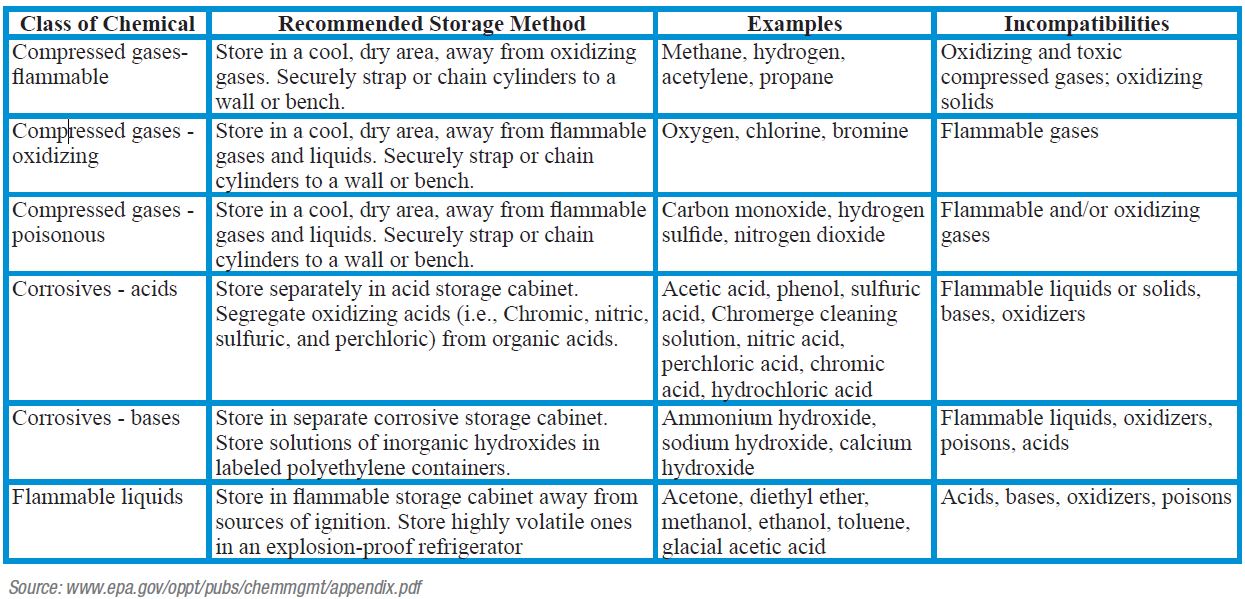Classroom demonstrations and student laboratory experiments must be handled carefully. To carry out such activities without shielding and other precautions can have serious consequences: in some instances students and teachers have found themselves in hospital emer- gency rooms.
Such accidents can be prevented or at least contained by a good school chemical safety management program. Labs house by far the largest number of chemicals in schools, and should have a chemical safety management program, much of which is required by law.
The elements of a good plan are described here. The standards and regulations that codify many of the elements of such plan are listed in the sidebar.
Elements of chemical safety management
A written chemical hygiene plan— If multiple chemicals or chemical procedures are used, a written chemical hygiene plan is required. The written plan must be developed and implemented by the district. Such a plan sets forth procedures, equipment, personal protective equipment, and work practices to protect staff from the health and safety hazards presented by hazardous chemicals used in laboratories.
If multiple chemicals or chemical procedures are not required, the PEOSH Right to Know (RTK) and Hazard Communication standards would apply instead. The RTK survey can satisfy survey requirements of both laws.
Staff information and training—A Material Safety Data Sheet (MSDS) from the manufacturer and a Hazardous Substance Fact Sheet (HSFS) from the New Jersey Department of Health must be provided for each chemical in use. Science teachers must be trained on how to detect the presence or release of a hazardous chemical, the physical and health hazards of chemicals in the work area, and protective measures to control exposure.
Exposure control—Science teachers should observe proper chemical handling techniques, use lab hoods, and use personal protective equipment such as gloves, chemical splash goggles, lab coats, and aprons. Any class demonstration by the teacher of a procedure that has the potential for an uncontrolled reaction should be shielded.
Proper storage—Storing incompatible chemicals together is one of the most common errors the New Jersey Department of Environmental Protection (DEP) fi nds on inspection. Chemi- cals should be stored by compatibility, not alphabetically (see box). Shelves should have a lip to prevent spills from spreading, or chemicals should be stored in pans with a lip. They should not be stored above eye level.
Labeling—Label shelving, cabinets, and chemical containers with a color- coded numbering system that will allow containers to be easily returned to their proper location.
Fire control—Basic fire control includes proper storage of fl ammable liquids (see box), providing sand buckets, fi re blankets, fi re alarms, and fi re extinguishers.
Spill clean-up—Spill procedures and kits for major categories of hazardous materials should be available so that staff members know what to do if a spill occurs.
Clean-out—Chemicals that are outdated (more than two years old), unwanted, in excess, dangerous, or unlabeled should be discarded. If staff members do not have time to do a clean-out all at once, it is a good idea to have some kind of label, like a colored sticker, to mark chemicals that are ready for disposal, and store them with compatible chemicals. Then a school- wide or districtwide disposal day can be used to dispose of them properly.
Safe disposal—Hazardous wastes must not be poured down the sink or put in the trash. Federal and state regulations are complicated. You can work with your UniServ fi eld repre- sentative and your district to learn how your district manages hazardous waste (see sidebar).
Buy chemicals in small quantities— Teachers should not buy more than they will use up in a school year. A good idea is to use lab kits (pre- mixed chemicals in quantities suffi cient for use by an individual class), or microscale or green chemistry approaches to laboratory experiments.
Chemical Storage by Chemical Class

Keeping labs safe
Hazardous Waste Disposal Most school districts already have a contractor to dispose of hazardous wastes. The local association can also call the county health department and speak to the county environmental health coordinator.
For more information
- National Institute of Occupational Safety and Health: The School Chemistry Laboratory Safety Guide is a very thorough guide to all aspects of chemical management: www.cdc.gov/niosh/docs/2007-107/pdfs/2007-107.pdf.
- Environmental Protection Agency: The Toolkit for Safe Chemical Management in K-12 Schools has many resources: www.epa.gov/schools/toolkit.html.
- HAZCOM self-inspection checklist: www. state.nj.us/health/forms/occ-38.pdf.
- Hazardous Substance Factsheets give health and safety information on over 1,500 chemicals. Hundreds are also available in Spanish: nj.gov/health/eoh/rtkweb/index.shtml.
The rules to support the procedures
- Chemical hygiene plan: Occupational Exposure to Hazardous Chemicals in Laboratories: PEOSH Standard 1910.1450
- Right to Know: PEOSH Right to Know: N.J.A.C. 8:59
- Hazard Communication: Hazard Communication: N.J.A.C. 12:100-7
- Personal Protective Equipment:
- Protective Clothing: PEOSH Standard 1910.132
- Eye and Face Protection: PEOSH Standard 1910.133
- Gloves: PEOSH Standard 1910.138 Medical Services and First Aid (including eyewash and shower): PEOSH
- Standard 1910.151.
- Fire Control: Portable extinguishers: PEOSH Standard 1910.157
